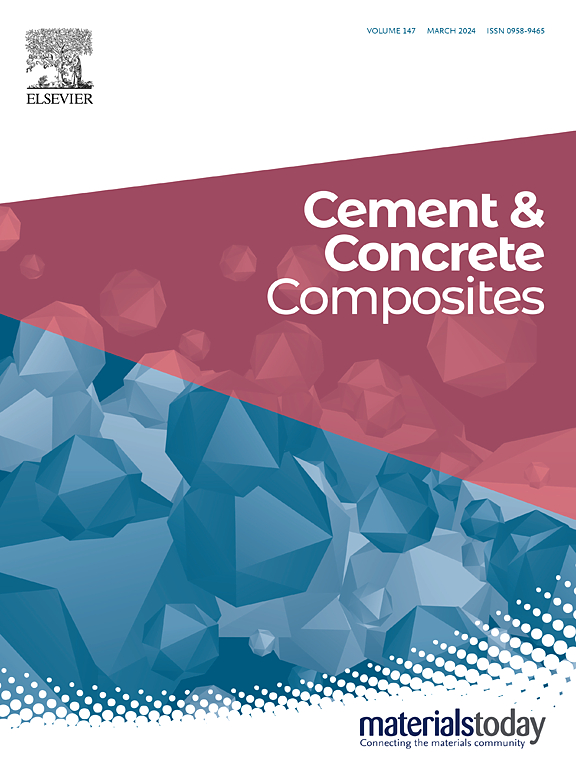宏聚甲醛纤维对循环荷载下混凝土梁受弯性能的影响及裂缝发展的自监测潜力
IF 13.1
1区 工程技术
Q1 CONSTRUCTION & BUILDING TECHNOLOGY
引用次数: 0
摘要
研究了纳米碳粉(NCP)聚甲醛纤维增强混凝土(POMFRC)在单调弯曲和循环弯曲作用下的力学性能和裂缝自感知行为。对缺口梁进行了循环弯曲试验,并测量了阻力分数变化(FCR),实现了裂缝的实时监测。分析了不同剂量的宏聚甲醛纤维和NCP用量对POMFRC力学性能和自传感灵敏度的影响。在单调加载和循环加载条件下,研究了挠度、裂纹张开位移(CMOD)和FCR之间的关系。结果表明:POM纤维显著改善了材料的开裂后性能,NCP纤维增强了材料的自感知灵敏度;平均而言,1 kg/m3的NCP使1 mm偏转时的FCR值提高61.1%。首次探讨了循环荷载作用下混凝土裂缝的自感知问题。从第一个加载-卸载周期开始,FCR的变化趋势与CMOD相似。混凝土开裂后,在加载和卸载过程中,FCR和CMOD同时增加或减少,在开裂后阶段表现为正相关关系。基于单调试验数据的线性模型为循环弯曲下FCR-CMOD关系的初步预测提供了一种简单实用的方法,提供了保守可靠的裂纹张开估计。本文章由计算机程序翻译,如有差异,请以英文原文为准。
Effect of macro polyoxymethylene fiber on the flexural behavior of concrete beam under cyclic loading and the potential for self-monitoring of crack development
This work investigates the mechanical properties and crack self-sensing behavior of polyoxymethylene (POM) fiber reinforced concrete (POMFRC) with nano-carbon powder (NCP) under monotonic and cyclic bending. Cyclic bending tests are conducted on notched beams, and the fractional change in resistance (FCR) is measured to enable real-time crack monitoring. The effects of varying macro POM fiber and NCP dosages on the mechanical properties and self-sensing sensitivity of POMFRC are analyzed. The relationships between deflection, crack mouth opening displacement (CMOD), and FCR are examined under both monotonic and cyclic loading conditions. Results reveal that POM fibers greatly improve post-cracking performance, while NCP enhances self-sensing sensitivity; on average, 1 kg/m3 NCP enhances the FCR value at a 1 mm deflection by 61.1 %. For the first time, the self-sensing of concrete cracks subjected to cyclic loading is explored. From the first loading-unloading cycle, the variation in FCR shows a similar trend to that of CMOD. After concrete cracking, both FCR and CMOD increase or decrease simultaneously during loading and unloading, which reflects a positive correlation in the post-cracking stage. A linear model derived from monotonic test data offers a simple and practical approach for preliminary prediction of the FCR-CMOD relationships under cyclic bending, providing conservative and reliable estimates of crack opening.
求助全文
通过发布文献求助,成功后即可免费获取论文全文。
去求助
来源期刊

Cement & concrete composites
工程技术-材料科学:复合
CiteScore
18.70
自引率
11.40%
发文量
459
审稿时长
65 days
期刊介绍:
Cement & concrete composites focuses on advancements in cement-concrete composite technology and the production, use, and performance of cement-based construction materials. It covers a wide range of materials, including fiber-reinforced composites, polymer composites, ferrocement, and those incorporating special aggregates or waste materials. Major themes include microstructure, material properties, testing, durability, mechanics, modeling, design, fabrication, and practical applications. The journal welcomes papers on structural behavior, field studies, repair and maintenance, serviceability, and sustainability. It aims to enhance understanding, provide a platform for unconventional materials, promote low-cost energy-saving materials, and bridge the gap between materials science, engineering, and construction. Special issues on emerging topics are also published to encourage collaboration between materials scientists, engineers, designers, and fabricators.
 求助内容:
求助内容: 应助结果提醒方式:
应助结果提醒方式:


